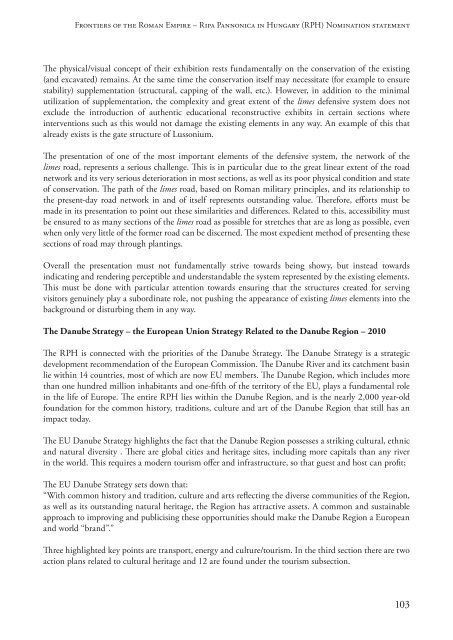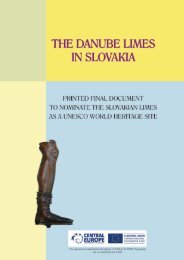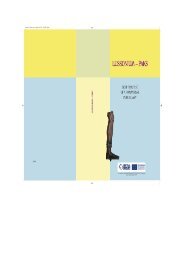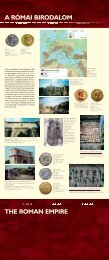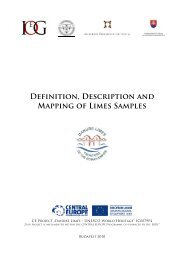the PDF version! - Danube Limes
the PDF version! - Danube Limes
the PDF version! - Danube Limes
You also want an ePaper? Increase the reach of your titles
YUMPU automatically turns print PDFs into web optimized ePapers that Google loves.
Frontiers of <strong>the</strong> Roman Empire – Ripa Pannonica in Hungary (RPH) Nomination statement<br />
The physical/visual concept of <strong>the</strong>ir exhibition rests fundamentally on <strong>the</strong> conservation of <strong>the</strong> existing<br />
(and excavated) remains. At <strong>the</strong> same time <strong>the</strong> conservation itself may necessitate (for example to ensure<br />
stability) supplementation (structural, capping of <strong>the</strong> wall, etc.). However, in addition to <strong>the</strong> minimal<br />
utilization of supplementation, <strong>the</strong> complexity and great extent of <strong>the</strong> limes defensive system does not<br />
exclude <strong>the</strong> introduction of au<strong>the</strong>ntic educational reconstructive exhibits in certain sections where<br />
interventions such as this would not damage <strong>the</strong> existing elements in any way. An example of this that<br />
already exists is <strong>the</strong> gate structure of Lussonium.<br />
The presentation of one of <strong>the</strong> most important elements of <strong>the</strong> defensive system, <strong>the</strong> network of <strong>the</strong><br />
limes road, represents a serious challenge. This is in particular due to <strong>the</strong> great linear extent of <strong>the</strong> road<br />
network and its very serious deterioration in most sections, as well as its poor physical condition and state<br />
of conservation. The path of <strong>the</strong> limes road, based on Roman military principles, and its relationship to<br />
<strong>the</strong> present-day road network in and of itself represents outstanding value. Therefore, efforts must be<br />
made in its presentation to point out <strong>the</strong>se similarities and differences. Related to this, accessibility must<br />
be ensured to as many sections of <strong>the</strong> limes road as possible for stretches that are as long as possible, even<br />
when only very little of <strong>the</strong> former road can be discerned. The most expedient method of presenting <strong>the</strong>se<br />
sections of road may through plantings.<br />
Overall <strong>the</strong> presentation must not fundamentally strive towards being showy, but instead towards<br />
indicating and rendering perceptible and understandable <strong>the</strong> system represented by <strong>the</strong> existing elements.<br />
This must be done with particular attention towards ensuring that <strong>the</strong> structures created for serving<br />
visitors genuinely play a subordinate role, not pushing <strong>the</strong> appearance of existing limes elements into <strong>the</strong><br />
background or disturbing <strong>the</strong>m in any way.<br />
The <strong>Danube</strong> Strategy – <strong>the</strong> European Union Strategy Related to <strong>the</strong> <strong>Danube</strong> Region – 2010<br />
The RPH is connected with <strong>the</strong> priorities of <strong>the</strong> <strong>Danube</strong> Strategy. The <strong>Danube</strong> Strategy is a strategic<br />
development recommendation of <strong>the</strong> European Commission. The <strong>Danube</strong> River and its catchment basin<br />
lie within 14 countries, most of which are now EU members. The <strong>Danube</strong> Region, which includes more<br />
than one hundred million inhabitants and one-fifth of <strong>the</strong> territory of <strong>the</strong> EU, plays a fundamental role<br />
in <strong>the</strong> life of Europe. The entire RPH lies within <strong>the</strong> <strong>Danube</strong> Region, and is <strong>the</strong> nearly 2,000 year-old<br />
foundation for <strong>the</strong> common history, traditions, culture and art of <strong>the</strong> <strong>Danube</strong> Region that still has an<br />
impact today.<br />
The EU <strong>Danube</strong> Strategy highlights <strong>the</strong> fact that <strong>the</strong> <strong>Danube</strong> Region possesses a striking cultural, ethnic<br />
and natural diversity . There are global cities and heritage sites, including more capitals than any river<br />
in <strong>the</strong> world. This requires a modern tourism offer and infrastructure, so that guest and host can profit;<br />
The EU <strong>Danube</strong> Strategy sets down that:<br />
“With common history and tradition, culture and arts reflecting <strong>the</strong> diverse communities of <strong>the</strong> Region,<br />
as well as its outstanding natural heritage, <strong>the</strong> Region has attractive assets. A common and sustainable<br />
approach to improving and publicising <strong>the</strong>se opportunities should make <strong>the</strong> <strong>Danube</strong> Region a European<br />
and world “brand”.”<br />
Three highlighted key points are transport, energy and culture/tourism. In <strong>the</strong> third section <strong>the</strong>re are two<br />
action plans related to cultural heritage and 12 are found under <strong>the</strong> tourism subsection.<br />
103


